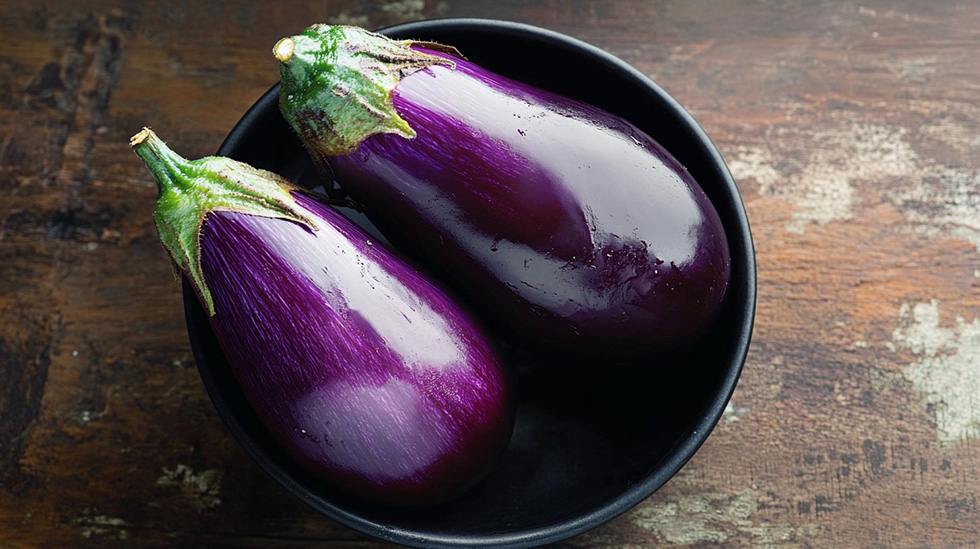Aubergine – the purple star who always has something new to show
The aubergine or eggplant (Latin: Solanum melongena) is one of the most stylish vegetables on the vegetable counter: its shiny purple skin, elegant shape and versatile kitchen use make it a favourite with many – but others still look at it and wonder what to do with it. But it’s worth making friends with, because aubergines are more than just a showy vegetable: they’re healthy, exciting and sometimes even tricky. 😊

Known names, origin, history
Aubergines are known by several names, depending on the country you ask. In Hungarian, it is also called eggplant – not for nothing, because there are varieties that are actually egg-shaped and egg-coloured. In English it is eggplant, in French aubergine, in Italian melanzana. Its native habitat is probably India and South-East Asia, where it has been grown for thousands of years. It was introduced to Europe by the Arabs and for a long time was known only as an ornamental plant because many people thought it was poisonous. In medieval Europe, for example, it was thought to ‘drive people mad’. Today we know that it is nothing to be afraid of – in fact, it is a joy to cook with!
Its importance in the kitchen
4/5 – Aubergines are the star of Mediterranean, Middle Eastern and Asian cuisines and are gaining ground in Hungarian households. Although it is not a staple vegetable like peppers or tomatoes, it is the basis of many iconic recipes. It is a great meat substitute, can be varied, grilled, baked and cooked. Once you learn to cook it well, you never want to cook without it.
Which part is edible?
The edible part of the aubergine is the fruit itself, the shiny, purple, pear or cylindrical part that you can find in the shop. It is important to always eat them when ripe, as overripe or too young aubergines can be bitter. The skin is also edible, although it may be a little thicker on larger specimens – peel it off.
The leaves and stems are not edible and may contain a toxic substance called solanine, so they are not allowed. For the same reason, it is important to always use only well-ripened aubergines.
Health benefits
Aubergines are a low-calorie, fibre-rich vegetable that is great for diets. It is rich in antioxidants (such as nasunin, which is found in the purple skin) – this protects cells from oxidative stress. It contains vitamin C, B vitamins, potassium and magnesium.
According to folk medicine, it can also help lower cholesterol, regulate blood sugar levels and improve digestion. It’s also filling, so you’ll feel full for a long time.
Production, season, origin
In Europe, aubergines are mainly grown on a large scale in Spain, Italy and France – Spain being the largest producer. It is also grown in Hungary, mainly in greenhouses, but you can also see it outdoors in the warmer summer months.
The domestic aubergine season runs from June to September. During this time, it is advisable to buy from domestic sources. The rest of the year it is typically imported (mainly from Spain and the Netherlands).
How to choose good aubergines
It’s not complicated, just pay attention to a few little things:
- Colour: should be bright, dark purple with a shiny, reflective skin.
- To the touch: firm but not rock-hard. When you press it with your finger, it springs back slightly.
- Stems: should be green and fresh, not dry or brown.
- Avoid dented, wrinkled, soft specimens!
Storage at home
Do not refrigerate the aubergines as they are sensitive to cold and will soften and wilt more quickly. Store them in a cool, dark place (such as a pantry or pantry) and try to use them within 2-3 days.
If you’ve cut it up and there’s some left, wrap it in foil or an airtight container and it’s ready to go in the fridge – but use it within a few days.
Aubergines in the kitchens of the world
- In Italy: the famous melanzane alla parmigiana, fried aubergine slices layered with tomato sauce and cheese.
- In Greece: muszaka – minced meat, eggplant, layered with béchamel sauce.
- In India: baingan bharta – smoke-roasted aubergine, cooked with tomatoes and spices.
- In Turkey: imam bayıldı – fried aubergine with a tomato-onion stuffing.
- In France: ratatouille – vegetable ragout with aubergine, courgette, peppers and tomatoes.
Most popular recipe: aubergine cream
Aubergine cream (or vineta in Transylvanian) is one of the simplest and most delicious uses of aubergines. Fry the aubergines whole in the oven or over an open flame until they soften and the skin blackens. Peel, drain and mix with chopped onion, salt, pepper and mayonnaise or oil to taste. Delicious cold on toast! 😋
Tips for use in the kitchen
- Don’t eat it raw! Aubergines are not tasty raw and can be slightly bitter.
- Grill, roast, braise or boil! Almost every heat treatment will make it finer.
- Seasoning: garlic, basil, thyme, rosemary, cumin, curry and smoked paprika are very good.
- What you should avoid: very sweet, dessert spices (cinnamon, vanilla) are not friendly to aubergines.
So aubergines are not only beautiful, they can be versatile, healthy and a kitchen superhero – if you get to know them and learn how to use them. Don’t be afraid to experiment with it – because once you love it, you’ll always have room for it in your pantry!
